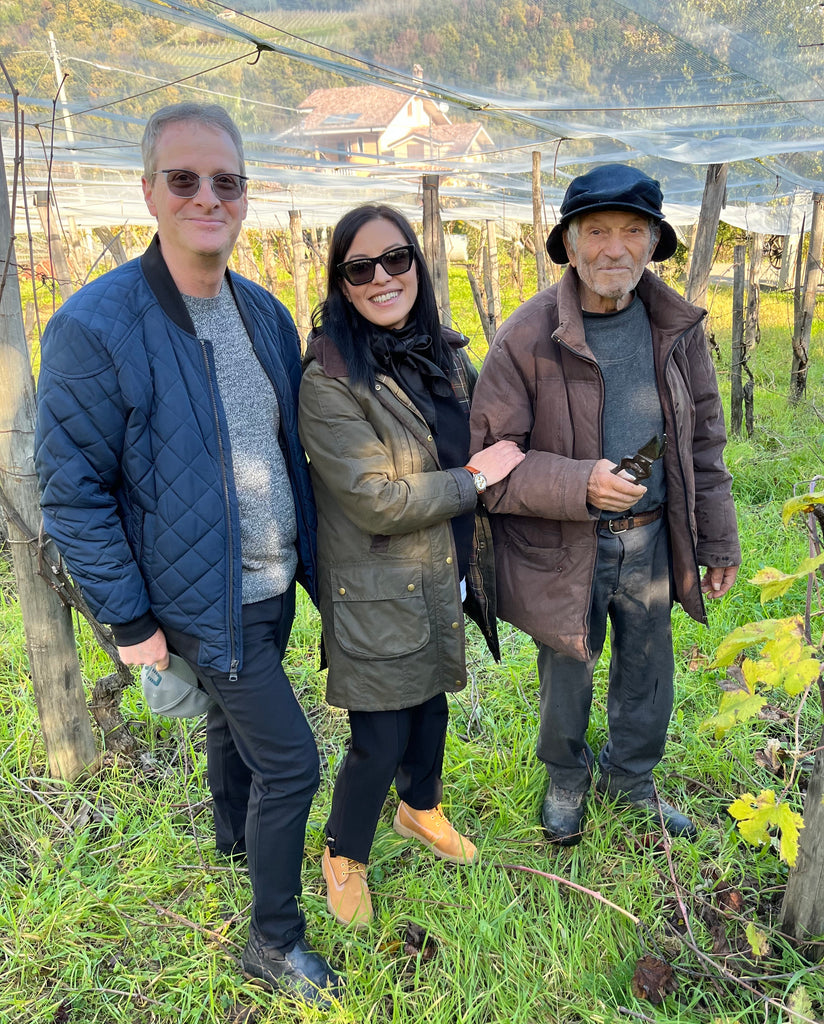Our tasting impressions
WOW - JUST WOW! The aromatics of the 2018 Mèrcori are a powerful but pleasurable assault that seem to impact all your senses. I thought the nose on the 2017 was incomparable (it out performed a stellar 2000 Lynch Bages). But this probably exceeds it. A taste reveals that it is also deeper, bigger and more intense. There is an exotic sweet and sour note that suggests tamarind to me. It is haunting and wildly provocative. Right now, it's a bit tight and the tannins are evident, though silky. This is one for the cellar, for sure - park it next to your other treasures.
For those who haven't tried Mèrcori, this may seem like hype. You need to try this wine to understand. Then you will rejoice in knowing that you are one of the lucky few to own such a unique, distinct and extraordinary wine.
About this wine
This is the third vintage of Francesca's top wine. Mèrcori is a field blend and truly an expression of a single vineyard planted up to 70 years ago by Nonno Luigi. A variety of grapes are grown on this 40° slope with .8 ha of vines on French and American rootstocks, trained in the Guyot system. The soil is rich in limestone, clay and marl. At the top of the slope - about 250 meters, Francesca pours the must from the previous vintage to fertilize - creating a circle of life for this special vineyard.
The 2018 is a blend of 30% Aglianico, 30% Cabernet Sauvignon, 10% Barbera, 10% Sangiovese and 20% other native varieties including Agliancone.
Harvesting, by hand, commenced October 10th. The grapes are sorted and selected twice - once in the vineyard and again in the cellar on a vibrating table. The grapes are pressed and then the stems, separately. Fermentation is in plastic vats. Maceration is 30-40 days with punch downs.
The wine is moved to neutral French tonneaux (some new, some up to 3 years old) to age for up to 2 years. The wine from each variety is blended in Botti and then transferred to tanks for bottling, where it rests for another year. With pen in hand, Francesca numbers each of the 1,965 bottles (a welcome increase of more than 50% over the prior year).
About the grape
Aglianico is one of Italy's three most prestigious grape varieties - along with Nebbiolo and Sangiovese. Grown mostly in southern Italy, it is at its best from Campania and Basilicata. It thrives in a warm and dry climate. Cabernet Sauvignon, famous the world over, is hearty fruit that flowers and ripens late. It is highly adaptive to a wide variety of climates and soils. Its vines are capable of prodigious production, which must be restricted in order to produce the grape's best quality. Barbera is a dark-skinned grape from vigorously growing, easy to manage vines. It is high in acidity, low in tannins and light-bodied.
Sangiovese is the most planted grape in Italy. It is dark and thick-skinned, slow-ripening, acidic and tannic. Principal among the other native varieties is Aglianicone, which, despite its name and genetic similarity to Aglianico, is actually a version of Ciliegiolio. The other grapes are unclassified and even Francesca doesn't know the names of some of them.
Francesca's thoughts on the vintage
For 2018, temperatures were above normal in the winter, with sporadic rains. In February, rain was intense at times with snow in the higher elevations. This was followed by a Serbian front that plunged temperatures to below zero. Most of March was warmer until a nationwide frost that did considerable damage to the buds. Spring and rising temperatures arrived mid-April, but May started rainy and windy. The weather was typical for most of the spring and summer without being excessive and the right amount of rain allowed ideal flowering and fruit setting. Sunny days, cool temperatures (especially at night) and the absence of sea winds allowed for a truly excellent phenolic maturation of the grapes with the possibility of developing good aromas and acidity.
On your table
Presently, this needs a dish that can tame its tannins, structure and young fruit. It was glorious with osso bucco, despite almost all of Italy between their regions. Later in life, go with a very simple dish and leave Mèrcori to every bit of the spotlight it deserves. Best at cool cellar temperature in a large bowled, Bordeaux-style glass.
Francesca Fiasco is young, passionate and driven. Since 2015, she has relentlessly worked the land and cellar her grandparents started many decades ago in the beautiful Cilento National Park (a preserve that prohibits any industrial activity). Everything she knows about farming and wine she learned from her Nonno. More than 90 years old, Luigi still tends the vines.
From the 6.5 hectare farm (comprised of various small vineyards), Francesca produces less than 20,000 bottles per year from a mixture of traditional local grapes, some typical of other regions of Italy and one conspicuous interloper from France - Cabernet Sauvignon. Production of her 4 wines is unconventional - it's Nonno's way - but the results are remarkable. The expectation from a farm like this, in an area like this, is that the wines will be rustic, simple and honest. Instead, we find sophistication and complexity without compromising a clear expression of the place they come from.
To say that this is manual labor is an understatement. It starts with the grapes for each wine being harvested separately and concludes with Francesca writing notes on each case of wine leaving her cellar. Her devotion and determination are undeniable. The wines from Paestum may not be well-known or highly regarded but don't tell her that - nor does anyone who has tasted her wines much care. Wow, what a discovery! Only the great story of this family and Francesca's project can outshine her wines.
